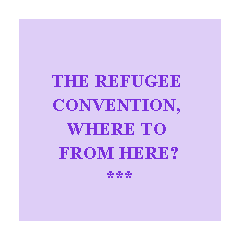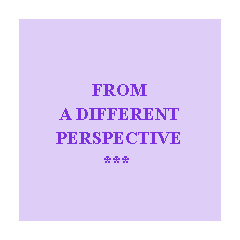No 21. May 2002.
https://www.arts.uwa.edu.au/MotsPluriels/MP2102edito1.html
© Eileen Pittaway
Eileen Pittaway
Centre for Refugee Research, The University of New South Wales
|
|

Who is a refugee?
According to the 1951 Convention Relating to the Status of
Refugees, a refugee is a person who 'owing to a well-founded fear of being
persecuted for reasons of race, religion, nationality, membership in a
particular social group, or political opinion, is outside the country of his
nationality, and is unable to or, owing to such fear, is unwilling to avail
himself of the protection of that country'. (UN 1951)
In 2002, Mr Rood Lubbers, the United Nations High Commissioner for Refugees (UNHCR) has over 22 million refugees under his protection. Additionally, there are an estimated 25 million displaced people in the world who live in dangerous and vulnerable situations within their own countries. Over eighty percent of these refugees and displaced persons are women and their dependant children. They are subject to continuing violence and are the targets of rape and sexual abuse, which are used as strategies of war. They live in substandard conditions, often without adequate food, without sufficient water, and with ad hoc access to medical services and education. They are recognised as among the most vulnerable people in the world. (Pittaway, 2001)
It is now 50 years since the Refugee Convention, was written and signed by 140 nations of the world. It was designed to protect refugees from ongoing persecution and harm, it recognises that the right to seek asylum from persecution is a fundamental and universal human right, enshrined in the Universal Declaration of Human Rights. Since the convention was written, the world has changed dramatically and the face of the refugee has changed from that of a European to that of every race on earth. The political, social and economic forces that shape our world have altered beyond recognition. Borders of nations states have shifted. Globalisation has homogenised the ways in which we live. There are unprecedented movements of people across borders, for reasons such as inter and intra country conflict, ethnic conflicts and natural disaster. The world is struggling to deal with these changes.
As one of the many international activities held to mark 50 years of International Protection for refugees, a conference was hosted by the Centre for Refugee Research, University of New South Wales, to examine how relevant the 51 Convention is in the twenty first century. When planning for the conference commenced, it was hoped that the coverage of issues would be truly international. However, during 2001, Australia's treatment of asylum seekers became international news, causing controversy and distress both within Australia and across the world. It became a major agenda item at events such as the UN World Conference Against Racism in Durban August 2001, a meeting of the Society for International Development, a European think tank, at Den Haag, September 2001, and at the Executive Committee meeting of the United Nations High Commissioner for Refugees, Geneva, September 2001. It was reported in the world press and by international news programs. It was therefore inevitable that a major focus of the conference became that of Australia's refugee policy. The majority of the papers in this special edition of Mots Pluriels were drawn from that conference and the the Conference Report is now available on the Center for Refugee Research web page.
Fear of (political) persecution is the only ground for refugee status, and the definition of what constitutes persecution, and the interpretation of what constitutes a particular social group have become the centre of debate around international obligations under the terms of the convention. The terms 'economic refugee" and 'environmental refugee' have been introduced into the debate, suggesting that the narrow definition of political persecution must be widened and that the nation states have international responsibilities which go beyond the narrow definition of the refugee convention. The question of whether people forced to migrate for reasons other than persecution should be included in the refugee convention, or whether a new Human Rights instrument and process are needed to address their needs are a subject of considerable controversy.
The United Nations High Commissioner for Refugees has identified three 'Durable Solutions' to address the refugee situation. These are (i) settlement in a country of first asylum, which relates to situations when a person flees from persecution in their own country and seeks asylum under the protection of another country; (ii) resettlement in a third country, which refers to removal of a refugee from temporary protection in a country of asylum to permanent settlement in a third, usually developed, country; and (iii) repatriation to the country of origin, which refers to the return of refugees from a country of first asylum once the danger is deemed to have discontinued.

The crucial question of WHY in the twenty first century, the world has
created so many refugees is discussed by ![]() . He explores some
of the reasons that this is happening, and the responses to refugees by other
nation states. He notes that these are often knee-jerk and defensive rather
than humanitarian. Importantly, within the context of a globalised economic
system, he introduces the notion of global citizenship. That refugee flow
is a global issue, and the impacts of the unplanned and unwanted movement
of people on host countries is further discussed by
. He explores some
of the reasons that this is happening, and the responses to refugees by other
nation states. He notes that these are often knee-jerk and defensive rather
than humanitarian. Importantly, within the context of a globalised economic
system, he introduces the notion of global citizenship. That refugee flow
is a global issue, and the impacts of the unplanned and unwanted movement
of people on host countries is further discussed by ![]() . This is particularly true in developing countries which, host the majority
of the worlds 22 million refugees. These countries are often unable to provide
adequately for their own people and the burden of an increased population can
be crippling.
. This is particularly true in developing countries which, host the majority
of the worlds 22 million refugees. These countries are often unable to provide
adequately for their own people and the burden of an increased population can
be crippling. ![]() explores the links, which have developed, between
states and individuals since the 18th century and addresses the vexed
issue of stateless people, who do not enjoy the protection of ANY nation state.
The children of many refugees fall into this amorphous category.
explores the links, which have developed, between
states and individuals since the 18th century and addresses the vexed
issue of stateless people, who do not enjoy the protection of ANY nation state.
The children of many refugees fall into this amorphous category.
Not all countries have the same response to refugees and asylum
seekers, and one areas of debate at present in Australia is whether the
experience of the latter can be equated with the experience of other developed
countries such as those in the European block. ![]() describes the way in which Germany is responding to the phenomena.
describes the way in which Germany is responding to the phenomena.
![]() 's literary survey suggests a continuous flow of
refugees toward France throughout the Twenthieth Century and the resettlement of
refugees in France is discussed by
's literary survey suggests a continuous flow of
refugees toward France throughout the Twenthieth Century and the resettlement of
refugees in France is discussed by ![]() , who describes how political
refugees are seen to be more readily accepted by officialdom than other categories of
migrants.
, who describes how political
refugees are seen to be more readily accepted by officialdom than other categories of
migrants. ![]() ,
,
![]() and
and
![]() bring us
into the reality of the refugee camps from which refugees and asylum seekers
most often leave to seek resettlement in other, safer countries. The focus is
on nutrition of children in camps and the paper implicitly questions the
rhetoric used by developed countries, that camps are places of protection, and
that once refugees reached the 'safety" of those camps, there are no reasons,
either legal or ethical for them to seek asylum elsewhere. The impacts of globalisation in relation to the provision of education for
refugee children is explored by
bring us
into the reality of the refugee camps from which refugees and asylum seekers
most often leave to seek resettlement in other, safer countries. The focus is
on nutrition of children in camps and the paper implicitly questions the
rhetoric used by developed countries, that camps are places of protection, and
that once refugees reached the 'safety" of those camps, there are no reasons,
either legal or ethical for them to seek asylum elsewhere. The impacts of globalisation in relation to the provision of education for
refugee children is explored by ![]() and
and
![]() , who
relate this particularly to challenges faced in Australian schools. They
explore how some citizens of host countries use notions of culture as a weapon
against perceived outsiders.
, who
relate this particularly to challenges faced in Australian schools. They
explore how some citizens of host countries use notions of culture as a weapon
against perceived outsiders.

The second group of papers examines the various experiences of refugees and
asylum seekers. A first hand account of the refugee experience can be
found in an interview with Congolese refugee
![]() .
. ![]() challenges us to consider and to
address the root causes of refugee flow. Her arguments are provocative and
challenging to developed countries as she suggests that in order to address the
refugee issue we have to acknowledge not only the role of the developed worlds
in providing the solutions, but also their role in causing the problems, which
generate refugee flow.
challenges us to consider and to
address the root causes of refugee flow. Her arguments are provocative and
challenging to developed countries as she suggests that in order to address the
refugee issue we have to acknowledge not only the role of the developed worlds
in providing the solutions, but also their role in causing the problems, which
generate refugee flow. ![]() brings us to Australia and the
experience of those refugees who are granted temporary protection under new
legislation. He argues that these laws and policies are adding significantly
to the trauma experienced by refugees and their ability to cope with
resettlement in a third country. His focus is on the experience of this group
of people in the community.
brings us to Australia and the
experience of those refugees who are granted temporary protection under new
legislation. He argues that these laws and policies are adding significantly
to the trauma experienced by refugees and their ability to cope with
resettlement in a third country. His focus is on the experience of this group
of people in the community. ![]() further explores this theme
focusing on the psychological trauma experienced by TVP holders and the impact
of this treatment on their mental health and thence their ability to cope with
life in Australia.
further explores this theme
focusing on the psychological trauma experienced by TVP holders and the impact
of this treatment on their mental health and thence their ability to cope with
life in Australia.
On a positive note, one of the most often commented on attributes of
refugees is their resilience, and their ability to rebuild their lives once
given the opportunity. ![]() writes of the experience of a
group of Bosnian refugees resettled in Western Australia, and the strategies
that some of them have used to facilitate the process of adaptation to a very
different life. Taking an unusual aspect of refugee resettlement,
writes of the experience of a
group of Bosnian refugees resettled in Western Australia, and the strategies
that some of them have used to facilitate the process of adaptation to a very
different life. Taking an unusual aspect of refugee resettlement, ![]() and
and
![]() examine the concepts of leisure, joy and freedom
for refugee women. They explore how these concepts are an integral part of the
resettlement process, and how political events impact on these. Finally in this
section,
examine the concepts of leisure, joy and freedom
for refugee women. They explore how these concepts are an integral part of the
resettlement process, and how political events impact on these. Finally in this
section, ![]() ,
,
![]() and
and
![]() examine the
growing body of literature on the psychological treatment of refugees, and test
these against the experience of refugees in the Australian community.
examine the
growing body of literature on the psychological treatment of refugees, and test
these against the experience of refugees in the Australian community.
The focus on Australian policy and practice in these papers can be regarded as a case study, which illustrates the political nature of the refugee issue. While responses differ from country to country, the political aspect is constant, and has to be acknowledged in the search for a long-term solution for the unprecedented mass movement of people in the world today. About 11 000 people enter Australia annually on either Refugee or Special Humanitarian visas as part of the resettlement program. Others arrive from refugee or refugee-like situations as part of the Family Reunion Program. These entrants, the 'Off-shore' component of Australian refugee policy, are part of Australia's total annual immigration intake of approximately 125 000. They are selected from refugee camps and situations where they have previously sought asylum, and are screened prior to acceptances for resettlement to Australia, using criteria which are focused more on selecting refugees who have good indicators for successful resettlement than on humanitarian need (National Population Council, 1991). Once in Australia they are granted permanent residency status. (A brief history of refugee policy in Australia)
'On-shore' Asylum Seekers are people who escape from situations of danger and seek asylum in Australia. Their experience is very different to those selected for resettlement overseas. Refugee advocates have been concerned about Australia's treatment of on-shore asylum seekers for many years. However, it was not until the racist and xenophobic hysteria produced by Ms Pauline Hanson and the one Nation Party in the late 1990's, and the subsequent response by the Federal Government culminating in the Tampa affair, that most people became aware of the fact that each year a modest number of asylum seekers reach Australia and claim asylum here. Nor were they aware of the policy of mandatory detention of asylum seekers and all that it entails. This is covered in detail in section three of this edition of Mots Pluriels, "Australia's Treatment of Refugees and Asylum Seekers".

The treatment of asylum seekers in Australia became a major issue of concern at
the December conference. It is of international interest because the response
of Australia, especially when considered in its historical context, can inform
our understanding of different responses in countries across the world.
What is peculiar to Australia is the policy of mandatory detention of all
asylum seekers who arrive by boat, including children. As an
introduction to this section, ![]() provides us with some
very interesting insights into the current attitudes towards refugees and
asylum seeker in Australia and challenges the reader to understand these at a
philosophical level. She demonstrates the power of discourse to influence
public opinion.
provides us with some
very interesting insights into the current attitudes towards refugees and
asylum seeker in Australia and challenges the reader to understand these at a
philosophical level. She demonstrates the power of discourse to influence
public opinion.
![]() , who starts with the contention, shared by most Human
Rights Advocates, that in its treatment of asylum seekers, Australia is
contravening Human Rights law, presents possible alternatives to mandatory
detention. The notion of "national interest" is introduced into the debate by
, who starts with the contention, shared by most Human
Rights Advocates, that in its treatment of asylum seekers, Australia is
contravening Human Rights law, presents possible alternatives to mandatory
detention. The notion of "national interest" is introduced into the debate by
![]() . She argues that the policy of "deterrence" is in
fact antithetic to notions of protection and that the violation of the human
rights of asylum seeks harms national interest because of damage to our
international reputation.
. She argues that the policy of "deterrence" is in
fact antithetic to notions of protection and that the violation of the human
rights of asylum seeks harms national interest because of damage to our
international reputation.
The two papers by ![]() and
and
![]() both seek to
identify how Australia has reached its current position on Detention. They
present interesting and different views of how this has happened, McMasters
argues that the policy is a natural progression from the white Australia policy
reflecting an inherent racism in the Australian community, cleverly manipulated
by politicians. Rivett, while deploring the recent legislative changes, in
particular those pertaining to temporary protection visas, contends that the
development of detention policy is not merely based on racism, but is grounded
in genuine concern for the safety of Australian citizens, and the possibility
of Australia being put into a position of hosting more refugees than it is able
to accommodate. These differing views highlight the difficulties in gaining
consensus about such emotive issues, and the problems faced as the world
struggles to come to grips with an ever-increasing problem.
The final paper by
both seek to
identify how Australia has reached its current position on Detention. They
present interesting and different views of how this has happened, McMasters
argues that the policy is a natural progression from the white Australia policy
reflecting an inherent racism in the Australian community, cleverly manipulated
by politicians. Rivett, while deploring the recent legislative changes, in
particular those pertaining to temporary protection visas, contends that the
development of detention policy is not merely based on racism, but is grounded
in genuine concern for the safety of Australian citizens, and the possibility
of Australia being put into a position of hosting more refugees than it is able
to accommodate. These differing views highlight the difficulties in gaining
consensus about such emotive issues, and the problems faced as the world
struggles to come to grips with an ever-increasing problem.
The final paper by ![]() and
and
![]() details the
latest developments in Australian Legislation designed to deter asylum seekers,
and analyses these in relation to our international obligations under Human
Rights law. They find them to be sadly lacking.
details the
latest developments in Australian Legislation designed to deter asylum seekers,
and analyses these in relation to our international obligations under Human
Rights law. They find them to be sadly lacking.

The notion of a journey, or a road is often used allegorically to
describe the refugee experience. In this special edition of Mots Pluriels we
have tried to cover many of the stages on the journey or stops along the road.
What emerges most strongly from these papers is that the refugee issue is a
political issue and that politcal imperative overrides humanitarian principles
at every stage of the journey. Human Rights are malleable and the individuals
who become refugees are pawns in an international game, in which increasingly,
state sovereignty has become the prize, and individual rights are subsumed to
this end.
Governments interpret definitions of what constitutes a refugee and an asylum seeker differently across the world. Nation States employ varying interpretations at different times in their history. These interpretations are driven by global forces, by economic pressure and by political positioning. Domestic law and policy is shaped by these ever changing forces and refugees are swept along in the changes - maybe in the twenty first century, a fast flowing river is a more apt allegory than a road.
Sadly, even though the fact that the majority of refugees are women and children, and this was tabled at the UN Third World Conference on Women, Nairobi, 1985, and is restated in all major UNHCR documents since then, refugee policy and practice is still on the whole, gender blind. The use and abuse of women and children is seldom acknowledged, and the special needs of this group are often not addressed. Whilst of excellent calibre, the papers delivered at the December conference were once again surprisingly silent on this issue.
These silences lead to lack of action or inadequate services. Nation states defend their actions by blaming and demonising refugees and asylum seekers and by fortifying national border in the name of sovereign rights. The answer to the problems of refugees, which is increasingly considered as part of the even bigger problem of mass unauthorised people movement is incredibly complex. It involves an examination of the root causes of refugee flow; an acknowledgement of the at least partial culpability of the developed world in supporting and even generating many of the circumstances which cause these flows. It involves an acknowledgement that 80% of refugees are women and children and they have special needs. An examination of the way that aid is provided in situations of refuge, of the process of settlement and resettlement; and the services provided to refugees to assist them in these processes is also essential.
Finally it needs a though examination of the way in which the nation states of the United Nations define and interpret the Refugee Convention. Refugee advocates are demanding the introduction of some mechanism to ensure accountability, such as an Optional Protocol to the Refugee Convention, or the appointment of a Special Rapporteur on Refugees, answerable to the Human Rights Commissioner to ensure that in the future, standards of compliance are set, and reporting processes are in place. New provisions have to be made for the additional tens of millions of people displaced by economic and environmental factors. Until these macro issues are addressed, refugee flow will increase, nation states will put in place increasingly draconian measures to defend their borders, with unforseen long term consequences, and people smuggling will flourish. Protection will become another form of persecution.
Bibliography
National Population Council (1991). The National Population Council's Refugee Review. July 1991, Canberra: AGPS.
Pittaway, E. Bartolomei, L. (2001). "Refugees, Race and Gender", Refuge. Vol.19 no.6, Ontario York University.
 | Eileen Pittway is the Director of the Center for Refugee Research, University of New South Wales, where she lecturers in the area of International Social Development. She has been actively involved in refugee issues and the women's movement for over twenty years. Her major focus has been on the recognition of Rape in conflict situations as a war crime. She is a member of Asian Women's Human Rights Council, and co-chair of Asia Pacific Women's Watch (APWW), a network of women's Non Government Organisations in the Asia Pacific Region. She has a particular interest in the relationship between the United Nations and civil society and is an academic editor of The Australian Journal of Human Rights. |
Back to [the top of the page] [the contents of this issue of MOTS PLURIELS]